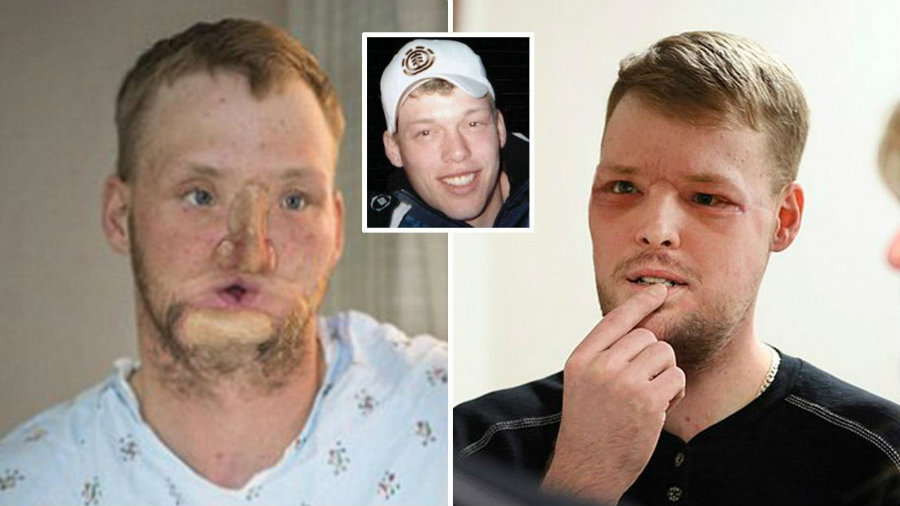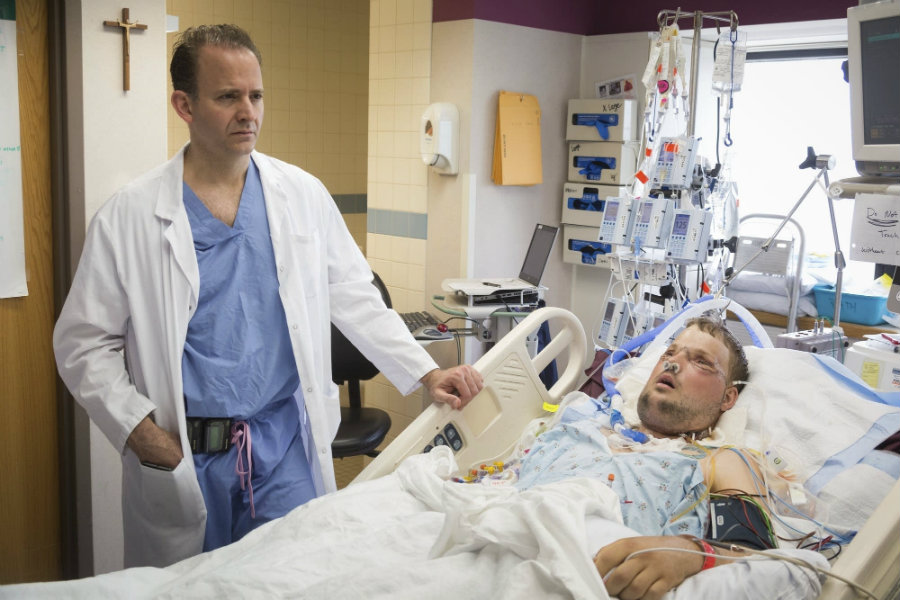Andy Sandness received the first face transplant surgery performed at the Mayo Clinic in Rochester, Minnesota, one of the rarest surgeries in the world. The 31-year-old man from Wyoming had attempted suicide with a gun one decade earlier, leaving his face unrecognizable.
Dr. Samir Mardini, a specialist in facial reconstruction, and his team of more than a dozen people had spent over 50 Saturdays over the course of more than three years in a human anatomy lab, refining their surgical techniques and rehearsing their approach. They had previously traveled to France, Boston, and Cleveland to meet with doctors who had performed the face transplant before.

They would practice the surgery on sets of cadaver heads, using 3D imaging and virtual technology to study how to trace out the cuts of one face so it would fit correctly on the other.
On June 16, 2016, the team of about 60 surgeons, nurses, anesthesiologists, and more, came together to carry out the 56-hour long face transplant. Sandness was wheeled into surgery late Friday. Dr. Mardini was all the way beside him, saying as they parted he was looking forward to seeing him with a new face. Doctor and patient had developed a close relationship over the years.
Going into surgery, Sandness felt confident everything was going to turn out well.
It took the medical specialists over 24 hours to obtain the donor’s face and almost as long to prepare Sandness. An additional 32 hours were devoted to rebuilding his face. The medical staff took turns throughout the weekend until the surgery was completed Monday morning.
“Everybody went into this totally knowing their role, knowing what to expect. Every step has been thought out 1,000 times,” explained Mardini, as reported by syracuse.com
Below his eyes, his entire face belonged to someone else. He was given the nose, cheeks, mouth, lips, jaw, chin, and even the teeth of the donor.
The surgeons had to identify facial nerve branches through electric stimulation in order to learn each of their functions and make the correct transfers from one man’s face to the other’s.
Mardini declared the surgery “a miracle”
Sandness was sedated for a couple of days. For three weeks he wasn’t allowed to see himself in the mirror- removed from his room- until the big reveal, an emotional scene described by his father as “beyond our wildest dreams.”
Not being able to speak, Andy wrote in a notebook his first impressions as he examined himself in the mirror for the first time.
“Far exceeded my expectations,” said the message that Dr. Mardini read to the gathered family and group of doctors and nurses who had worked on his face.
After the successful face transplant, Sandness had follow-up surgery to tighten the skin on the face and neck and to build up bone around his eyes. He received speech therapy to learn to use his tongue in a new mouth and jaw. His face muscles are getting stronger as he can breathe and smell normally again. Now, he’s able to eat food that was restricted to him before.
He plans to return to his hometown and continue working as an electrician. He hopes to marry and build a family of his one day.

How his medical journey began
Two days before Christmas of 2006, Sandness found himself at the edge of depression. He got a rifle from the closet and loaded the chamber. He put the barrel beneath his chin and looking down at it, pulled the killing shot, but he failed to take his own life. As soon as he fired the rifle, he knew he had made the biggest mistake of his life. When first responders arrived, Andy pled for help and asked them not to let him die.
He was treated at two hospitals before coming to the Mayo Clinic in Rochester, Minnesota. When he woke up, his mother was by his side holding his hand and telling him she loved him. The only thing he could do was apologize to his family for the pain he had caused them.
The bullet had obliterated his nose, he had no jaw, and his lips were almost entirely gone. He had shot out all but two of his perfect smile teeth. Some vision in his left eye was damaged. His eyelids had been spread apart by the blast from the gunshot.
At the medical center, Andy met Dr. Mardini, a plastic surgeon who promised he would fix his face as best as he could.
The doctors couldn’t miraculously get Andy’s face back. It would take a long time and many surgeries, and a lot of patience and strong will from Andy’s part.
A series of reconstruction surgeries followed. Dr. Mardini’s team removed the dead tissue and shattered bones, and attached titanium plates and screws to connect the remaining facial bones. Muscle tissue and bones from his hip were used to put together an upper jaw, and the same was done with his leg for the lower jaw.
After eight surgeries, Sandness went back home to Newcastle, Wyoming, where his friends and family welcomed him. He worked as an electrician’s apprentice and in the oil fields at a lodge.
Despite his doctor’s effort to give him back his face, some of his daily activities were compromised. With a mouth about an inch wide, he had to cut food into little pieces he would suck on before being able to swallow. His prosthetic nose fell constantly, and he had to carry glue with him to reattach it.
Even going grocery shopping was a struggle. He had to avoid eye contact with children so they wouldn’t get scared. He often overheard remarks about his appearance and was once even taunted on a night out. He retreated from social life and dedicated to hunting and fishing.
With time, he learned to adapt, but Andy never stopped wondering if there were any other possible alternatives.

In spring of 2002, Andy Sandness received a call from Dr. Mardini telling him about the launch of a face transplant program at the Mayo Clinic. Sandness looked like a perfect patient for it.
After hearing about it, Sandness was determined to go for it, not being disheartened by the risks of the procedure and the possible side effects of a life-long regimen of anti-rejection drugs. The doctors also wanted to make sure he had realistic expectations for the surgery. Andy wanted to regain the ability to bite, swallow and chew and a working nose back. The looks were just a “bonus,” Sandness said.
During the three more years Sandness waited for the program to be approved, he had to undergo rigorous psychiatric and social work evaluation, particularly to determine if a suicide survivor like him would be the ideal candidate for the innovative surgery. In the end, his resilience, his strong support system and his decade-long friendship with Dr. Mardini bowed in his favor
“I don’t think there’s anybody who doesn’t deserve a second chance,” Mardini reasoned.
Dr. Hatem Amer, Mayo Clinic’s director of reconstructive transplantation, also agreed to choose Sandness for the operation because he understood what he was getting into and in January 2006, Andy Sandness’ name was written on the waiting list of the United Network for Organ Sharing.
They would have to look out for a donor with matching blood and tissue types, approximately the same size, a close skin tone and within a 10-year age difference. Mr. Mardini reckoned the search could take up to 5 years.
Two men’s stories cross path
Calen “Rudy” Ross, a 21-year-old outdoorsman, had gotten breaking point in his life- the same age as Sandness was when his missed attempt to commit suicide- and in early June 2016 he fatally shot himself in the head. He wasn’t as lucky as Sandness, but one man’s tragedy was another man’s second opportunity at a normal life.
Despite mourning the sudden loss of her newlywed husband, Rudy’s wife Lilly decided to carry out her husband wish to become an organ donor. Lilly was eight months pregnant with a baby boy.
Rudy’s heart, lungs, liver, and kidneys were suitable and would be up for donation. What Lilly never imagined was her husband’s face would also be a good match for a transplant.
She was hesitant at first, at the thought of running into a man with Rudy’s face. But she soon gave her consent, arguing the joy of showing their son what his late father was able to do to ensure a better quality of life for some else.
Both Sandness and Lilly Ross expressed interest in learning more about each other.
Lilly wrote a letter to Sandness telling him more about his kind and adventurous husband. The two men’s similarities in looks and shared passion for the outdoors have been pointed out several times.
“He’s still going to continue to love hunting and fishing and dogs — through me,” said Sandness in an appreciation response to Lilly, according to syracuse.com
They hope to meet one day.
Source: Syracruse.com
